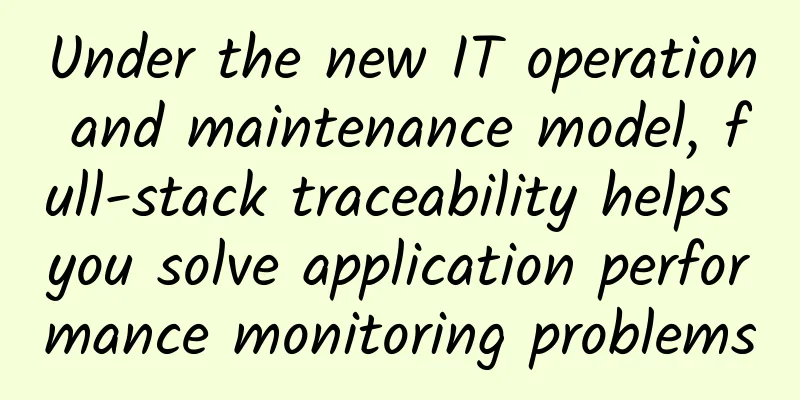Under the new IT operation and maintenance model, full-stack traceability helps you solve application performance monitoring problems

|
[51CTO.com original article] In 2016, Gartner changed the original five-dimensional definition of APM to three dimensions, namely: Digital Experience Monitoring (DEM), Application Discovery, Tracking and Diagnosis (ADTD), and Application Analysis (AA). In addition, Gartner also emphasized that the end-user experience is always the most important task of APM, and the core function of APM is to discover and diagnose problems based on applications. This change in definition stems from the new demands that users have put forward for APM under the new IT situation. In recent years, the growth of public cloud and mobile Internet has promoted the rapid development of APM market and technology. However, cloud computing, microservices and containerization have led to a massive increase in monitoring data, which has brought challenges to the development of APM. Microservice architecture and containerization make applications more flexible, elastic and scalable, but while improving application efficiency, they also make the application topology architecture and communication more complex and more difficult to monitor. At the same time, the scale of enterprise digital transformation is expanding, and various industries have put forward higher requirements for performance monitoring. Traditional monitoring solutions can only locate and solve less than 30% of the problems. What about the remaining 70%? How can we quickly locate the performance problems of end-user key businesses? How can we ensure the stable operation of all aspects of key business processes? In order to help enterprises cope with the difficulties of application performance monitoring under the new IT situation and help IT management teams quickly troubleshoot performance problems under different business logics, Tingyun, a domestic application performance management service provider, launched a full-stack traceability solution in 2016. It is the first in China to realize full-end, cross-application monitoring. In 2017, facing the current complex full-stack environment, positioning problems became more complicated. In order to be able to track and diagnose application performance problems more deeply, Tingyun full-stack traceability was fully upgraded. This upgrade is mainly based on the performance monitoring upgrade of user experience, realizing the platformization of tool products, and providing users with a comprehensive Tingyun full-stack traceability solution. According to Moca, vice president of Tingyun products, full-stack traceability is to locate and track full-stack problems based on transaction requests based on user experience. Currently, its main functions include: full-stack traceability of APP transaction requests, full-stack traceability of browser page transaction requests, full-stack traceability of dial-test transaction requests, and full-stack traceability of single users. "Full-stack traceability is a trend in the global APM industry. Overseas, established APM vendors such as Dynatrace and AppDynamics have already made full-stack traceability a standard feature of their products. However, in terms of functionality, Tingyun's technology is very advanced in China. Because our service system is more in line with the requirements of domestic enterprises, foreign APMs do not support domestic components, such as Alibaba Cloud's support based on microservice architecture, and localized technologies similar to the DAMO database." said Moca. Tingyun's full-stack traceability solution can achieve clear responsibility definition and provide a unified information platform for all departments to jointly discuss current application problems and solutions. The automatic quality control platform based on customer-critical business will shorten the problem-solving time from weeks to minutes. At the same time, when serious problems occur, the system will automatically respond and issue timely alarms. Since the full-stack traceability solution is based on user experience, how does Tingyun measure user experience? Moca explained that on the one hand, users can define user experience issues based on their own situation, such as the speed of response. On the other hand, Tingyun's full-stack traceability solution sets a default value. In addition, at the user perception level, for the first screen time, the time to click the control, etc., the system will find out whether the low user experience is caused by slow requests through the association of requests. So, for new technologies such as microservice architecture and containerization, can Tingyun's full-stack traceability solution solve the problem of application performance monitoring? In this regard, Moca said that, in simple terms, microservices are to divide the entire system into multiple small services. Taking Tingyun as an example, the entire monitoring system, reports, database query systems, etc. on the Tingyun server side can be split into microservices. The challenge here is that we used to be very clear that applications A, B, and C made up a system, but now we don’t know which microservices in applications A, B, and C make up a system. Because Tingyun is also using microservices and containers, while they bring many benefits such as flexibility and strong scalability, they also bring many bottlenecks to business management. Locating a problem requires locating a specific microservice. If it is a container, you need to consider which host to map it to, etc. These are the directions that Tingyun is working on. At present, Tingyun's full-stack traceability solution already supports containers. Because the core of the container is that it can be dynamically expanded, and when it is dynamically expanded, it will become many instances, and at this time it can be dynamically expanded according to these instances. So if you ignore the container layer and map the errors that can be specifically located to the container and the host, you can know where and what problems have occurred at the system level and infrastructure. Then locate the application level, and then disassemble the application, you can find out which container and server the application is specifically mapped to, and finally realize the monitoring of application performance. In an interview with ***, Moca said: "The core of full-stack traceability is to start from user experience and support a variety of complex environments. No matter what production environment the customer uses, we can provide support. This is one of the important criteria for us to go to the market and mature commercialization. This year, Tingyun's focus is to start from user experience, continuously improve the functions of the full-stack traceability solution, realize multiple perspectives, and make the product easier to use." [51CTO original article, please indicate the original author and source as 51CTO.com when reprinting on partner sites] |
<<: Survey shows: SD-WAN deployment is growing rapidly, MPLS will not disappear
Recommend
[6.18] Moack: $35.64/month-2xE5-2630L/32GB/1TB/10M bandwidth/South Korea server
Moack.co.kr is a Chinese merchant who mainly sell...
5G commercial use will be completed in one year, and the survey found that most consumers are still waiting and watching
Recently, Ms. He, a citizen, has frequently recei...
AkkoCloud: San Jose Triple Network CN2 GIA Line VPS Annual Payment Starting from 299 Yuan
AkkoCloud seems to be a newly established Chinese...
5G and blockchain empower each other and accelerate the digital economy
This year, many representatives and committee mem...
There is no problem in reaching 56% 5G penetration rate in the 14th Five-Year Plan
Zhang Yunyong, member of the National Committee o...
5G is a hot topic, but 4G module application data is still rising
According to the latest data released by the Mini...
Experience the Serverless application programming model in cloud native scenarios
background Alibaba Cloud Serverless Kubernetes (A...
LOCVPS newly launched Korean KVM, 20% off for all items, 2G memory package starts at 44 yuan per month
LOCVPS (Global Cloud) has released the informatio...
A look back at five major outages in 2019
Any time a network service outage occurs, it can ...
LiteServer 15th Anniversary 15% off, 2GB RAM NVMe hard drive package starts from €5.1/month
LiteServer is carrying out a promotion for its 15...
How to Develop an Effective Data Center Management Services Plan
Any organization that uses UPS power supplies hop...
Megalayer: Philippines/US/Singapore/Hong Kong VPS hosting, starting at 199 yuan per year
Megalayer is restocking VPS with special annual p...
How to replace the Query field in the URL?
[[420519]] When we write a crawler, we may need t...
Serverless Engineering Practice | Getting Started with Knative Applications from Zero Foundation
Introduction to Knative Knative implements its Se...
5G starts with the network taking the lead. H3C MSR 5G router promotes the implementation of 5G applications
In the era of the Internet of Everything, 5G, as ...









